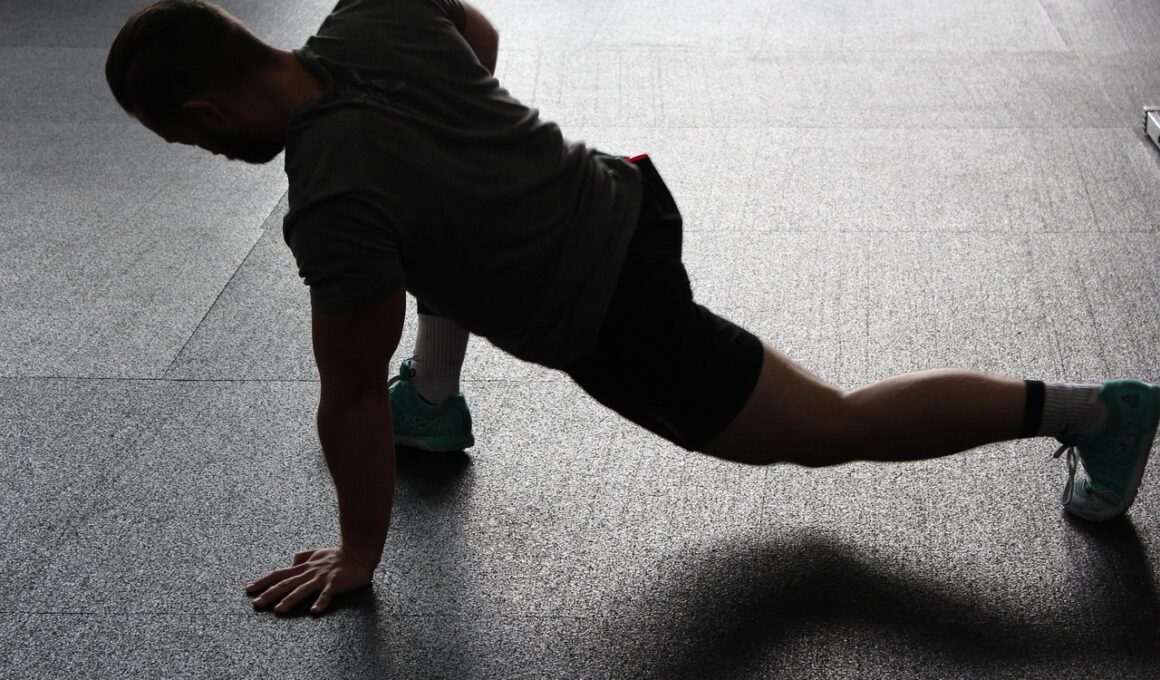Benefits of Dynamic Warm-Ups for Older Adults in Functional Fitness
Dynamic warm-ups are essential for older adults participating in functional fitness activities. These routines significantly improve flexibility, crucial for maintaining an active lifestyle. As people age, muscle elasticity tends to decrease, leading to a greater risk of injuries. Dynamic stretching helps to enhance blood flow to muscles and joints, preparing them for physical activity. Furthermore, improved flexibility contributes to better range of motion in daily tasks, making everyday activities easier and safer. Engaging in dynamic warm-ups also helps to develop neuromuscular coordination, enhancing body awareness. This coordination is vital for older adults as it may prevent falls and promote stability during movement. Studies show that engaging in these routines can lead to greater adherence to exercise programs, which is paramount for continued physical health and well-being. Moreover, dynamic warm-ups stimulate the central nervous system. This stimulation results in improved performance during both aerobic and strength-training exercises. In conclusion, incorporating dynamic warm-ups into a fitness regimen offers numerous benefits that support a more active and independent lifestyle for older adults.
Dynamic warm-ups not only enhance flexibility but also boost muscle strength, essential for older adults. Strength training is crucial for countering the natural decline in muscle mass associated with aging. Engaging in dynamic warm-up routines effectively activates multiple muscle groups. This activation helps prepare muscles for more intense workouts. Adding movements such as lunges, arm circles, and torso twists to a warm-up can strengthen specific muscles while improving coordination. Consequently, this leads to enhanced overall physical performance. Furthermore, these routines provide psychological benefits by increasing motivation and focus before workouts. Feeling prepared and mentally engaged can significantly influence participation rates in exercise programs. When older adults incorporate dynamic warm-ups into their routines, they experience increased levels of enjoyment and satisfaction in their workouts. This correlates with improved mental well-being, which is critical as emotional health plays a significant role in physical activity adherence. Additionally, improved muscular strength gained through dynamic warm-ups can lead to increased independence in daily living. Stronger muscles improve the ability to perform tasks, effectively lowering the risk of requiring assistance. Therefore, the role of dynamic warm-ups in enhancing strength cannot be overlooked.
Reduction of Injury Risk
A notable advantage of incorporating dynamic warm-ups is the reduction of injury risk among older adults. Aging can lead to a higher propensity for injuries during physical activities. Dynamic warm-ups increase circulation and improve the flexibility of muscles, which is vital for injury prevention. Increased blood flow warms up muscles, reducing stiffness and preparing them for exertion. During functional fitness activities, the lower risks of strains, sprains, and joint injuries are particularly beneficial. Additionally, dynamic movements improve balance, coordination, and proprioception, further lowering fall risk. Falls represent a significant health concern for older adults, often resulting in severe injuries or even hospitalization. Through regular practice of dynamic warm-ups, older adults can create a baseline of stability and strength, equipping them to manage everyday challenges effectively. Moreover, these routines actively engage various muscle groups. This full-body engagement helps to promote muscle symmetries and balances strength across the body, thereby minimizing imbalances that can lead to injuries. Regularly performing these warm-ups establishes a proactive approach towards injury prevention. Consequently, this enhances the overall quality of life for older adults, ensuring they can remain active throughout their later years.
Dynamic warm-ups can also foster social connections among older adults, promoting adherence to functional fitness regimes. Exercising in a group setting not only makes workouts more enjoyable but can also lead to lasting friendships. These connections provide emotional support while combating feelings of loneliness and isolation. Additionally, participating in group workouts often includes group warm-up routines. This added social aspect further motivates individuals to engage consistently in fitness activities. Research suggests that socializing during exercise contributes to improved mental health, which is essential for older adults. Enhanced mental health can lead to a more positive self-view about physical capabilities, further encouraging participation in these vital activities. Furthermore, dynamic warm-ups can serve as an introductory segment for educational discussions. Group sessions encourage sharing experiences, tips, and strategies related to fitness and wellness. This exchange of information is invaluable for older adults as they navigate their fitness goals. As participants share challenges and triumphs, they create a supportive environment vital for each individual’s journey. Ultimately, the social component of dynamic warm-ups can lead to stronger community bonds while enhancing both physical and mental health.
Functional Movement Patterns
Incorporating dynamic warm-ups into the routines of older adults facilitates the development of functional movement patterns. These patterns are essential as they mimic the movements required in daily activities. Ensuring older adults can perform basic functions without pain or difficulty is critical for maintaining independence. Dynamic warm-ups engage multiple joints and muscles used in everyday routines, which prepares the body for practical challenges. Movements like squats, arm swings, and hip circles enhance mobility, enabling older adults to navigate their living spaces with greater ease. This focus on functional fitness ensures that older adults can perform essential tasks confidently, such as bending to pick up objects or reaching overhead. Furthermore, by enhancing functional movements, dynamic warm-ups contribute to improved overall agility. Increased agility enhances reaction times, helping older adults to respond effectively to unexpected situations. For instance, a quick adjustment to avoid a fall can significantly impact maintaining independence. With improved confidence in performing everyday tasks, older adults experience a higher quality of life. Ultimately, integrating dynamic warm-ups into regular routines offers vital support for enhancing the performance of fundamental activities after transitioning into older age.
Dynamic warm-ups can also aid in weight management, which is crucial for older adults aiming to maintain a healthy weight. Extra weight can exacerbate several health issues, including joint pain and cardiovascular conditions. Engaging in warm-up routines effectively increases caloric expenditure, supporting weight loss or weight maintenance goals. This helps create a positive cycle where increased physical activity encourages healthier lifestyle choices. Furthermore, as older adults become more active and aware of their physical health through consistent warm-ups, they often adjust their nutrition and eating habits accordingly. A well-rounded diet, combined with the increased activity level, can lead to sustainable weight management. Additionally, dynamic warm-ups frequently boost metabolism. An improved metabolism can assist older adults in managing their weight, ensuring they remain healthy and active. Moreover, being engaged in consistent activity lowers stress levels, as physical exercise is a well-known stress reliever. Reduced stress contributes to healthier eating patterns by preventing emotional eating. As older adults integrate these warm-up routines into their fitness regimens, the benefits extend far beyond physical health, impacting overall well-being and self-satisfaction.
Conclusion
In sum, the benefits of dynamic warm-ups for older adults in functional fitness are profound and multifaceted. These routines promote flexibility, strength, and coordination while assisting in injury prevention and weight management. Additionally, they contribute significantly to improved mental health and social connections, crucial factors in sustaining an active lifestyle. Implementing dynamic warm-ups cultivates functional movement patterns essential for daily living. Moreover, the incorporation of social aspects enhances adherence to fitness regimes, fostering a supportive community among participants. Consequently, older adults feel empowered to maintain their independence and improve their overall quality of life. As the aging population continues to grow, it is imperative to recognize the importance of activities that protect their well-being and functionality. Through consistent practice of dynamic warm-ups, older adults can experience better mobility, increased strength, and enhanced mental clarity. Ultimately, these warm-up routines provide a holistic approach to fitness that is adaptable to the unique needs of older adults. Ensuring access to effective warm-ups allows older individuals to continue participating in functional fitness. This, in turn, enhances their ability to contribute meaningfully to their communities.
Engaging in functional fitness through dynamic warm-ups equips older adults with necessary skills for daily living. As improvements in health and mobility are achieved, individuals experience greater confidence in their physical abilities. This newfound confidence positively impacts mental well-being, which is essential for overall quality of life. The physical improvements extend beyond mere functionality, as older adults find enjoyment in their ability to partake in activities such as walking, gardening, or playing with grandchildren. These positive experiences serve to reinforce the importance of an active lifestyle. Moreover, the routine nature of dynamic warm-ups fosters discipline and structure within an individual’s fitness journey. Developing a consistent warm-up practice instills a sense of accomplishment that individuals can carry into other areas of their lives. This sense of achievement becomes particularly valuable when tackling other health-related challenges. By prioritizing health and mobility through preparatory routines, older adults can inspire their peers to embrace healthier lifestyles. Sharing successes and encouraging accountability creates a strong network of support that enhances collective commitment to fitness. As individuals witness the transformations achievable through dynamic warm-ups, they realize that the efforts invested yield invaluable returns.


